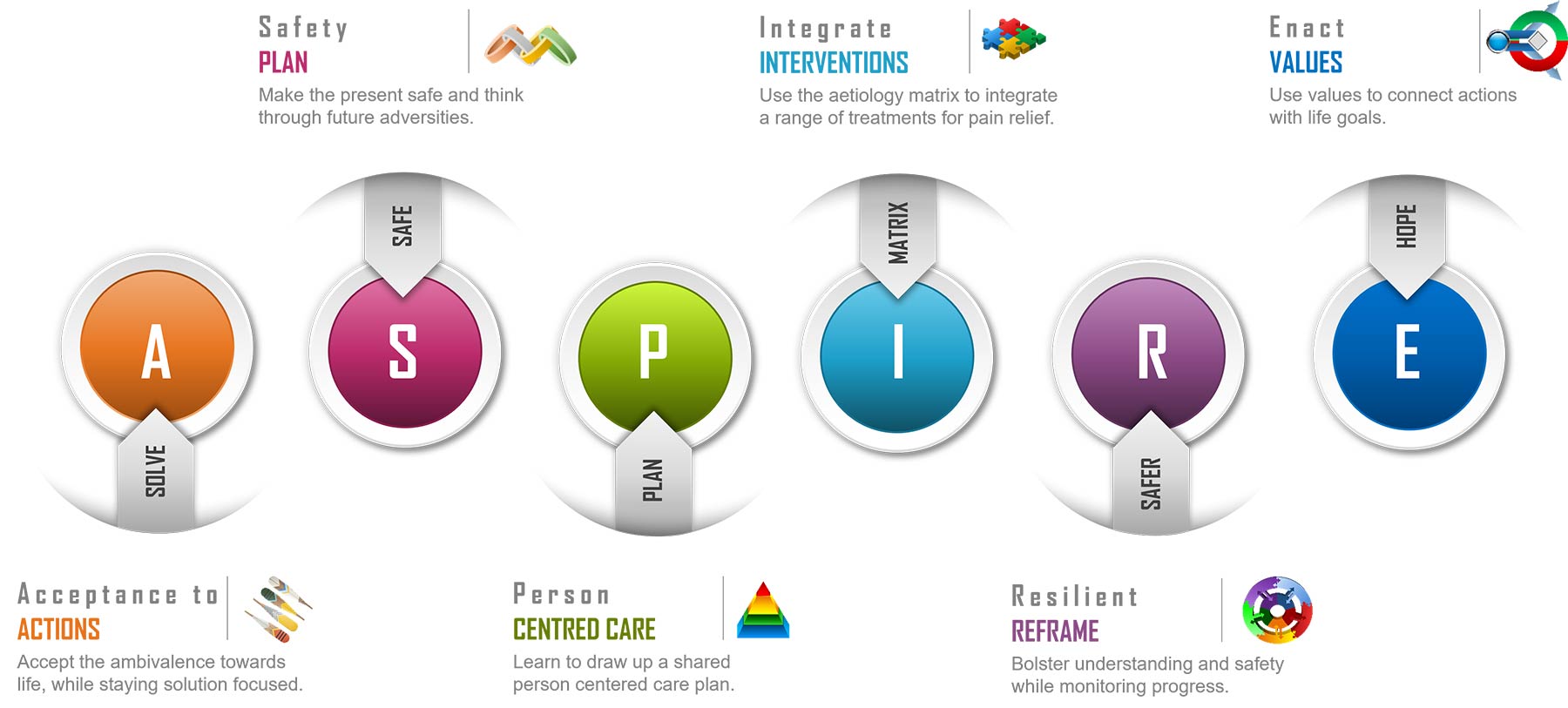Recovery Module for Suicide Prevention
From Safety Planning to Resilience Building

What is ASPIRE?
ASPIRE is the third and final module in PROTECT and covers the skills and knowledge needed to guide a person’s recovery journey from safety to resilience. Its eclectic and non-denominational, drawing on a number of approaches: Motivational Interviewing, Mindfulness, Dialectical Behavior Therapy, Behavioural Activation, Cognitive Behaviour Therapy, Acceptance and Commitment Therapy and conventional psychiatric care, all of which is underpinned through the person centered approach of relational safety.
At the core of ASPIRE is Acceptance, acceptance in the practitioner that all thoughts and actions taken by the person in suicidal distress is a response to the psychological pain. This is a prerequisite for the partnership ahead. Acceptance provides the grounding a professional needs to navigate ambivalence that the person feels towards a life of pain without getting into conflict or a power struggle. The core of acceptance enables a ring of actions. which can be thought of in a chronological sequence with safety planning in the midst of a crisis in the Emergency Department followed by the delivery of person centered care from an interventions menu along with monitoring that enhances coping and builds resilience for the future.
Key Principles
- Without risk there is no recovery – positive risks are the foundation of longer term safety
- With the right care the person has more control – enhance safety through partnership
- What matters to the person underlies the pain – target the cause for effective pain relief
Training Formats
ASPIRE and it’s component units are available in a number of training formats:
- 60 minute stand alone lectures – covers a unit
- 60 minute lecture series – sequentially covers all units e.g. in lunchtime meetings
- 90 minute seminars – covers a unit
- 4 hour masterclass – covers entire ASPIRE
- As part of 1, 2 or 3 day comprehensive courses
Learning Objectives
Gain Knowledge:
- Of Radical Acceptance
- Of Risk Response Balance Sheet approach
- Of the elements of person centered care
- Of brief interventions to support suicidal distress
Develop Understanding:
- Of how to navigate ambivalence towards life and living
- Of how to enhance safety in partnership
- Of how to use review sessions to enhance coping skills
- Of how to build resilience for the longer term
Refresh Skills:
- OARS from Motivational Interviewing
- Solution focused work for safety planning
- Behavioural Activation
- CBT skills
- Mindfulness strategies
- ACT strategies to embed values
Module Content
Summary of topics covered in ASPIRE
SOLVE: A core of acceptance, enables a ring of actions. Students are exposed to DBT based radical acceptance as a way of accepting the person’s psychological pain for what it is and helping the person accept the facts regarding the past and the present and reasonable possibilities of the future, not cognitive distortions, exaggerations or constriction. Students are then taught to a range of Motivational Interviewing skills (OARS skills) to navigate the ambivalence towards life many people experience when in suicidal distress. In the final section of this chapter students are exposed to SOLVE, a brief solution focused intervention designed to support a person to consider alternatives to suicide as the solution to the entrapment of life.
SAFE: The second module in ASPIRE is perhaps the most important and extensive in PROTECT. Safety Planning is a key component of ensuring safety and students are taught the Risk Response Balance Sheet approach within the SAFE framework to carry out scenario planning, reduce access to means, alcohol and other drugs, get the best out of their family, friends and follow up appointment and make an emergency plan. Students also learn the 1-2-7, a safety conversation to buy time while a detailed safety plan is collaboratively constructed. Please note SAFE is available as an online course that you can purchase now.
Person-centered care planning (PCCP) has increasingly been recognized as an essential intervention to restore fundamental freedoms to persons living with mental ill health and to transform the systems of care which serve them. The potential power of person-centered care planning has led to a call for its wide-spread adoption by many stakeholders around the world, but despite this sense of urgency, there remains much confusion regarding what PCCP looks like in practice, and how exactly it differs from traditional models of treatment planning. Students are introduced to the 4 component elements, each beginning with the letter P: Philosophy, Practice, Plan and Purpose.
Matrix: Students learn to consider all the options that are available to them, starting with different care providers across the statutory and NGO sector, followed by different settings from inpatients to community including primary care. Students also learn the appropriateness of specific management responses to the bio-psycho-social aetiological formulation that they have drawn up. This unit is primarily to help students to think broadly about recovery and draw on a range of supportive interventions from medication review by a psychiatrist to psychological interventions to social interventions like housing and finances.
SAFER: Monitoring within the PROTECT framework is done specifically to help the person become an expert in the management of their mental health challenges. Students are taught the review cycle, a CBT based tool that connects, triggers with thoughts and feelings and helps individuals modulate their responses. The strategies learnt are incorporated into the safety plan, enhancing coping strategies both internal and external.
HOPE: The final unit in ASPIRE uses an ACT based approach to build resilience. This is the VALUES unit in which students learn how to help a person connect with their values and take actions and form life goals that are values guided. They are also taught different strategies targeting the different domains of life (work / relationships / personal growth and health / leisure) and how values can be used to enrich each aspect.
